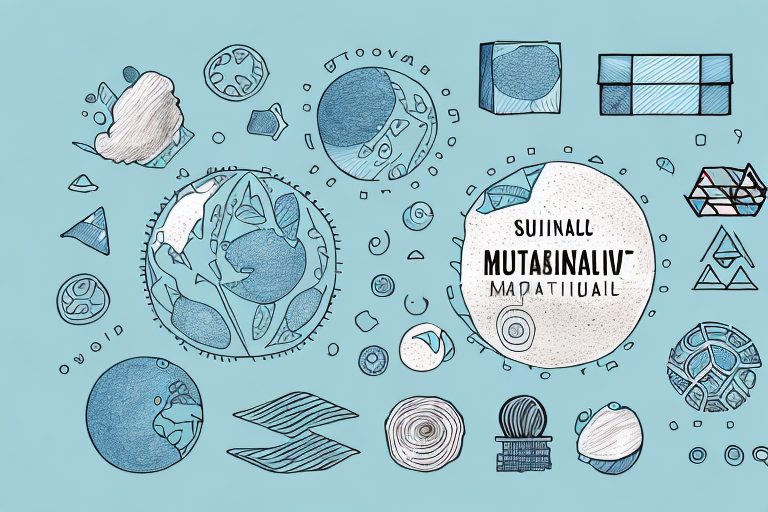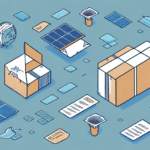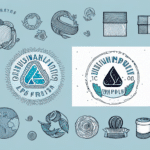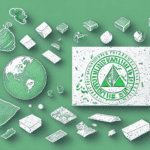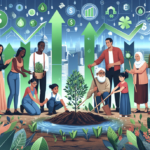In today's world, there is a growing concern about the impact of packaging waste on the environment. With the increasing awareness of global warming and the effect of non-biodegradable materials, it is time for businesses to rethink their packaging strategies. Eco-friendly packaging offers a sustainable solution for companies looking to make a positive impact on the environment while reducing their costs in the long run.
Why Eco-Friendly Packaging Matters in Today's World
Eco-friendly packaging is a responsible choice to reduce waste and increase sustainability. As customers become more environmentally conscious, their demand for eco-friendly products has skyrocketed. According to a [Nielsen study](https://www.nielsen.com/us/en/insights/article/2018/the-rise-of-the-influential-consumer/), 73% of global consumers say they would definitely or probably change their consumption habits to reduce their environmental impact. By providing eco-friendly packaging, businesses can make a statement about their commitment to sustainability, which can lead to increased brand loyalty and customer satisfaction.
Moreover, eco-friendly packaging can also help businesses save money in the long run. By using sustainable materials, businesses can reduce their packaging costs and minimize their carbon footprint. Additionally, eco-friendly packaging can help businesses comply with environmental regulations and avoid fines or penalties.
Finally, eco-friendly packaging can also have a positive impact on the environment. Traditional packaging materials, such as plastic and Styrofoam, can take hundreds of years to decompose and can harm wildlife and ecosystems. By using biodegradable and compostable materials, businesses can reduce their environmental impact and contribute to a healthier planet for future generations.
The Environmental Impact of Non-Eco-Friendly Packaging
Non-eco-friendly packaging materials contribute significantly to environmental degradation. They are non-biodegradable, which means that they either end up in landfills or the oceans, where they can take centuries to decompose. This leads to increased pollution and a negative impact on wildlife, marine life, and the overall ecosystem. According to the [Environmental Protection Agency (EPA)](https://www.epa.gov/facts-and-figures-about-materials-waste-and-recycling/plastics-material-specific-data), plastic waste makes up a significant portion of marine debris.
The production and disposal of non-eco-friendly packaging materials can emit harmful greenhouse gases and contribute to climate change. Additionally, the use of these materials leads to the depletion of natural resources. The production of these materials requires the extraction of non-renewable resources such as oil and gas, which are finite and will eventually run out. This not only contributes to environmental degradation but also poses a threat to the sustainability of our planet.
On the other hand, eco-friendly packaging materials such as biodegradable plastics, paper, and cardboard are sustainable and have a minimal impact on the environment. They are made from renewable resources and can be easily recycled or decomposed, reducing the amount of waste that ends up in landfills or oceans. By choosing eco-friendly packaging, we can reduce our carbon footprint and contribute to a healthier planet for future generations.
Exploring Sustainable Materials for Eco-Friendly Packaging
Businesses can switch to sustainable materials for eco-friendly packaging, which can reduce the impact on the environment. Examples of sustainable materials include:
- Biodegradable plastics
- Recycled paper and cardboard
- Plant-based materials such as bamboo and cornstarch
Additionally, businesses can opt for packaging material that is easy to recycle or compost, which reduces waste in the long run. It is essential to choose materials that are environmentally friendly while also maintaining high-quality standards.
Moreover, sustainable packaging materials can also have a positive impact on a business's brand image. Consumers are becoming increasingly aware of the environmental impact of packaging and are more likely to choose products that are packaged in eco-friendly materials. By using sustainable packaging, businesses can attract environmentally conscious consumers and differentiate themselves from competitors. Additionally, sustainable packaging can help businesses comply with environmental regulations and reduce costs associated with waste disposal. Overall, switching to sustainable packaging materials is a win-win situation for both businesses and the environment.
Understanding the Circular Economy and Its Role in Packaging Design
The circular economy is a concept that advocates for a sustainable economic model focused on responsible resource consumption and zero waste. In packaging design, a circular economy mindset means designing for reuse, recycling, or biodegradability. According to the [Ellen MacArthur Foundation](https://www.ellenmacarthurfoundation.org/circular-economy/concept), embracing the circular economy can significantly reduce waste and promote a sustainable ecosystem.
One of the key benefits of the circular economy in packaging design is the reduction of carbon emissions. By designing packaging that can be reused or recycled, we can reduce the need for new packaging materials, which in turn reduces the carbon footprint of the packaging industry. Additionally, the circular economy can create new business opportunities, such as the development of recycling facilities and the production of recycled materials.
However, implementing a circular economy in packaging design requires a shift in mindset and a collaborative effort from all stakeholders in the packaging industry. It involves rethinking the entire lifecycle of a product, from design to disposal, and finding ways to minimize waste and maximize resource efficiency. By working together towards a circular economy, we can create a more sustainable future for our planet.
Designing for Zero Waste: Techniques and Strategies
Designing for zero waste means creating sustainable packaging solutions that can reduce waste in the long run. The most critical factor is to create packaging that is easy to recycle, reuse, or biodegrade. Furthermore, it involves designing with the end goal in mind and considering the entire product lifecycle. Businesses can explore innovative techniques such as:
- Refillable packaging
- Compostable packaging
- Closed-loop systems
Another important strategy for designing for zero waste is to reduce the amount of packaging used in the first place. This can be achieved by using minimalistic designs, eliminating unnecessary layers, and using materials that are lightweight yet durable. Additionally, businesses can consider implementing a take-back program, where customers can return used packaging for recycling or reuse. By implementing these strategies, businesses can not only reduce waste but also save costs and improve their environmental footprint.
Best Practices for Reducing Packaging Waste in Your Business
Businesses can reduce packaging waste by implementing best practices such as:
- Analyzing and optimizing current packaging solutions
- Streamlining the production process
- Optimizing the supply chain for sustainability
- Investing in technology like environmental management software
- Setting goals and tracking sustainability metrics
Additionally, businesses can consider using alternative packaging materials such as biodegradable or compostable materials. These materials can break down naturally and reduce the amount of waste that ends up in landfills. Another option is to implement a closed-loop system, where packaging materials are reused or recycled within the business. This can not only reduce waste but also save costs in the long run. By adopting these best practices, businesses can not only reduce their environmental impact but also improve their reputation and appeal to eco-conscious consumers.
Innovations in Eco-Friendly Packaging: What's Coming Next?
The packaging industry is continually evolving, and innovative eco-friendly packaging solutions are emerging every day. Some of the most exciting innovations include:
- Edible packaging: Made from food-grade materials and fully biodegradable.
- Bio-based packaging: Created from plant materials like algae or mushroom-based materials.
- Airless packaging: Reduces the need for preservatives by limiting oxygen exposure.
- Nanotechnology: Used to create antimicrobial packaging that extends shelf life and reduces the need for preservatives.
Another exciting development is the increased use of recycled materials. Many companies are now using recycled paper, cardboard, and plastic to create packaging that is both sustainable and cost-effective. This not only reduces waste but also helps to conserve natural resources.
Furthermore, some companies are exploring the use of nanotechnology to create packaging that is not only eco-friendly but also has additional benefits. For example, nanotechnology can be used to create packaging that is antimicrobial, which can help to extend the shelf life of food products and reduce the need for preservatives. This technology can also be used to create packaging that is self-cleaning, which can help to reduce the spread of germs and bacteria.
The Cost of Eco-Friendly Packaging: Balancing Sustainability and Profitability
Switching to eco-friendly packaging may increase costs in the short term, but it can lead to long-term benefits like cost savings and reduced environmental impact. Businesses can consider sustainability as an investment that can help save costs on waste management in the long run. Additionally, eco-friendly packaging can improve the brand image, leading to increased brand value.
The key is to find a balance between sustainability and profitability. One way to achieve this is by exploring different eco-friendly packaging options. For example, using recycled materials or biodegradable packaging can be both cost-effective and environmentally friendly. Another option is to reduce the amount of packaging used, which can lead to cost savings and a smaller environmental footprint.
It's important to note that consumers are becoming increasingly aware of the environmental impact of packaging and are willing to pay more for eco-friendly options. This means that businesses can potentially increase their profits by offering sustainable packaging choices. In fact, a [Nielsen study](https://www.nielsen.com/us/en/insights/article/2018/the-rising-demand-for-sustainable-packaging/) found that 73% of global consumers say they would definitely or probably change their consumption habits to reduce their environmental impact.
Consumer Preferences for Eco-Friendly Packaging: Insights and Trends
Consumer preferences are a driving force in the demand for eco-friendly packaging. Studies show that eco-friendly packaging resonates with consumers, and many prefer environmentally friendly packaging over traditional, non-sustainable packaging. Consumers are also willing to pay a premium for eco-friendly packaging and are more likely to choose products with sustainable packaging over non-sustainable alternatives.
According to the [Cone Communications CSR Study](https://www.conecomm.com/research-blog/2017-csr-study), 87% of consumers would purchase a product because a company advocated for an issue they cared about, and 76% would boycott a company if they learned it supported an issue contrary to their beliefs. This highlights the importance of aligning packaging strategies with consumer values.
Case Studies: Successful Examples of Companies Implementing Eco-Friendly Packaging Solutions
There are many companies that have successfully implemented eco-friendly packaging solutions. For example:
- Patagonia: Switched to using biodegradable bags for its clothing, significantly reducing plastic waste.
- Lush: Replaced plastic packaging with paper-based solutions, promoting sustainability in the cosmetics industry.
- Unilever: Committed to making all of its plastic packaging fully reusable, recyclable, or compostable by 2025.
These companies demonstrate that eco-friendly packaging can be an effective solution for reducing waste and improving sustainability while maintaining product quality and brand integrity.
How to Communicate Your Commitment to Sustainability through Your Packaging
Communicating your commitment to sustainability through your packaging is crucial in building brand image and customer loyalty. Here are some strategies to achieve this:
- Use eco-friendly labels and certifications: Display certifications such as the [Forest Stewardship Council (FSC)](https://www.fsc.org/en), [Green Seal](https://www.greenseal.org/), or [B Corp](https://bcorporation.net/) to showcase your commitment.
- Incorporate messaging on packaging: Include messages that highlight the sustainability of your packaging materials and practices.
- Leverage social media and marketing campaigns: Share your sustainability efforts and eco-friendly packaging solutions through various marketing channels to reach a broader audience.
- Engage with customers: Encourage customers to participate in recycling programs or provide feedback on your packaging sustainability.
By effectively communicating your sustainability efforts, you can strengthen your brand reputation and foster deeper connections with environmentally conscious consumers.
Overcoming the Challenges of Switching to Eco-Friendly Packaging
The switch to eco-friendly packaging can be a daunting task, and businesses may face several challenges along the way. Common challenges include:
- Finding the right materials: Identifying sustainable materials that meet quality and functionality requirements.
- Cost considerations: Managing the initial investment required for transitioning to eco-friendly packaging.
- Supply chain adjustments: Adapting supply chain processes to accommodate new packaging materials and suppliers.
- Consumer acceptance: Ensuring that customers are receptive to changes in packaging design and functionality.
However, with the right strategy and support, businesses can overcome these challenges:
- Conduct thorough research: Explore various sustainable packaging options and their benefits to make informed decisions.
- Partner with experts: Collaborate with packaging experts and sustainability consultants to navigate the transition.
- Start small: Implement eco-friendly packaging solutions in select product lines to test their effectiveness before a full-scale rollout.
- Educate and engage: Educate employees and stakeholders about the benefits of eco-friendly packaging and engage them in the transition process.
By addressing these challenges proactively, businesses can successfully transition to environmentally sustainable packaging.
How to Measure the Environmental Impact of Your Packaging
Measuring the environmental impact of your packaging is essential in determining the effectiveness of eco-friendly packaging solutions. Here are some methods to assess impact:
- Environmental Management Systems (EMS): Implement an EMS to monitor and manage your packaging's environmental performance.
- Carbon Footprint Analysis: Calculate the total greenhouse gas emissions associated with your packaging throughout its lifecycle.
- Life Cycle Assessment (LCA): Conduct an LCA to evaluate the environmental impacts of packaging from production to disposal.
- Recycling Rates: Track the percentage of your packaging materials that are recycled or reused.
- Waste Audits: Perform regular waste audits to identify areas where packaging waste can be reduced.
By measuring environmental impact, businesses can continually assess their packaging designs and implement improvements to enhance sustainability. Tools and resources from organizations like the [Green Business Bureau](https://www.greenbusinessbureau.com/) and [Sustainability Accounting Standards Board (SASB)](https://www.sasb.org/) can assist in this process.
The Future of Sustainable Design: What's Next for Eco-Friendly Packaging?
The future of sustainable design is exciting, as businesses and consumers become increasingly aware of the environmental impact of their choices. In the packaging industry, innovators are exploring sustainable materials, designs, and manufacturing techniques that can minimize waste and reduce the environmental footprint. We can expect to see:
- Advanced biomaterials: Development of new sustainable materials that offer better performance and lower environmental impact.
- Smart packaging: Integration of technology to improve functionality while maintaining sustainability.
- Modular packaging designs: Creating packaging that can adapt to different products, reducing the need for multiple packaging types.
- Increased automation in recycling: Enhancing recycling technologies to handle complex packaging materials more efficiently.
- Consumer-driven innovations: Products designed with end-of-life disposal in mind, encouraging consumers to participate in recycling and reuse programs.
We can expect the integration of technology and sustainability to lead the way for more eco-friendly and innovative packaging solutions, paving the path for a greener future.















